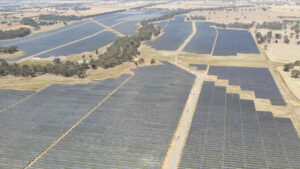Solar power is becoming increasingly dominant in growing number of energy markets, combining with wind power to provide more than two-thirds of new capacity additions in 2019, according to the latest global estimates published by BloombergNEF.
In 2019, solar emerged as the most popular new source of electricity generation capacity across a third of all countries, including Australia, India and the United States. BloombergNEF estimates that a total of 81 countries added at least 1MW of new solar capacity last year.
BloombergNEF estimates that 265GW of new generation capacity was added throughout 2019, with a total of 118GW of new solar capacity was added globally, topping all energy sources for the year.
It caps off a remarkable rise for the solar industry over the last decade, with the total solar capacity installed up until 2010 amounting to 43.7GW. The industry is now adding more than two and a half times that amount each year.
The findings have been detailed in BloombergNEF’s Power Transition Trends 2020 report, which attributed the market share gains achieved by wind and solar projects to falling costs and technology improvements.
“Sharp declines in solar equipment costs, namely the modules that go on rooftops and in fields, have made this technology widely available for homes, businesses and grids,” BNEF analyst and lead author of the study Luiza Demôro said. “PV is now truly ubiquitous and a worldwide phenomenon.”
New solar projects represented 45 per cent of new capacity additions in 2019, with new wind projects securing an additional 22 per cent market share.
With the inclusion of new hydroelectric plants, renewable energy projects provided more than 75 per cent of new capacity additions, with new fossil fuel projects representing just a quarter of new capacity added in 2019.
The rapid growth of the solar energy market has seen the technology surpass wind to become the fourth largest source of power globally on a capacity basis.
A total of 651GW of solar power has now been installed worldwide, with an additional 644MW of wind generation capacity. Both technologies sit behind coal (2,089GW), gas (1,812GW), and hydro (1,160GW) in terms of installed capacity, but those gaps are closing quickly.
While output from wind and solar has continued to grow, overall electricity generation from other sources has been in decline. Between 2018 and 2019, BloombergNEF estimated that global coal generation fell 3 per cent. While there are more coal plants in operation globally compared to a decade ago, those power plants are running less frequently, with utilisation rates falling to 50 per cent in 2019, down from 57 per cent from a decade earlier.
BloombergNEF found that some countries, particularly well-developed countries, are moving to mothball or decommission ageing fleets of coal fired power stations, as lower cost wind and solar begin to undercut existing fossil fuel generators on cost.
“Wealthier countries are moving quickly to mothball older, largely inefficient coal plants because they can’t compete with new gas or renewables projects,” head of Americas at BNEF Ethan Zindler said. “However, in less developed nations, particularly in south and southeast Asia, new, more efficient coal plants continue to come online – often with financial support from Chinese and Japanese lenders.”
While the analysis shows that well-developed countries dominated the market for new wind and solar projects during the early 2010s, by the end of the decade the balance had shifted, with a number of non-OECD countries, including Chile, Colombia, Mexico and Turkey sourcing a majority of new capacity additions through wind and solar projects each year since 2016.
While BloombergNEF noted that, due to lower capacity factors, wind and solar projects contributed a comparatively smaller proportion to the overall amount of electricity generated, the market share of the renewable energy sources had grown considerably over the last decade.
In 2010, solar contributed just 0.16 per cent to overall electricity generation, but by 2019, this share had grown to 2.7 per cent, an almost 17-fold increase over the last ten years.
Electricity sector emissions fell in the 2019 year, according to the BloombergNEF estimates, dropping by 1.5 per cent. The fall was due to declining electricity sector emissions in the United States and Europe which more than offset increases in emissions from China.
Electricity emissions are anticipated to fall further in 2020, due to the impacts of Covid-19, as slowing economies and a reduction in manufacturing activity expected to see electricity demand fall across at least 20 major economies.
The growth in renewable energy generation in Australia has been credited for driving down local electricity prices, as lower cost wind and solar have begun to push more expensive coal and gas generation out of the market, despite a lack of











